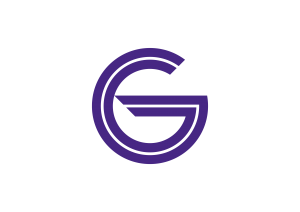
It continues to be a key element in the delivery of the draft Programme for Government.
The introduction of Glider has provided a modern, safe, accessible, efficient and high quality public transport service which has encouraged more people to travel by public transport instead of the private car.
Glider has helped to support sustainable economic growth and regeneration, and has helped to integrate communities though linking people to jobs, shops, leisure, health and educational services.
BRT Characteristics
There are a number of key principles underpinning the characteristics of BRT - Glider:
- a strong brand image that delivers a clear identity for the system
- high quality in all aspects of the system, including the fixed infrastructure, vehicles, operations and customer services
- high standards of reliability with punctual service operation and predictable journey times
- integration with other modes of sustainable transport
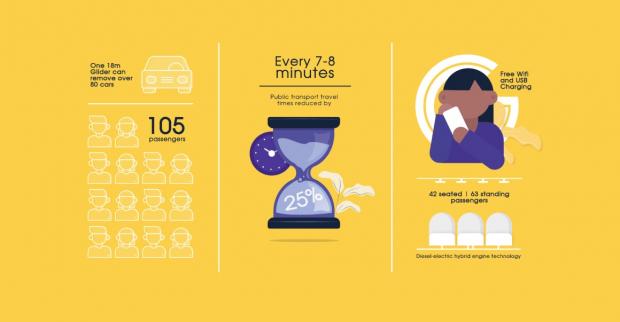
Glider Vehicles
The Glider vehicles are 18 metre articulated buses with a capacity of 105 people. These articulated vehicles provide a greater capacity than that provided by double deck buses. Articulated vehicles are widely accepted as the vehicle of choice for bus-based rapid transit systems worldwide.
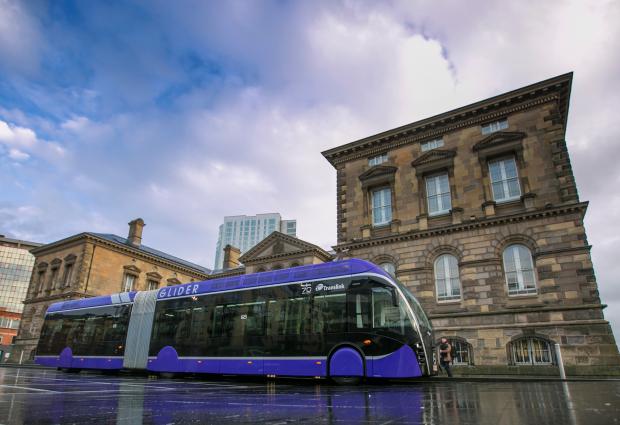
The Glider vehicles are a key part of the BRT system image. They have a strong identity and high quality appearance that is easily distinguishable from other public transport vehicles.
The Glider vehicles provide a high quality environment for passengers in terms of space, security and on-board information.
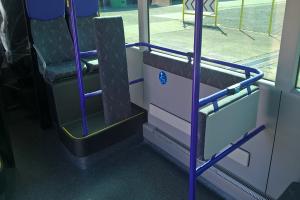
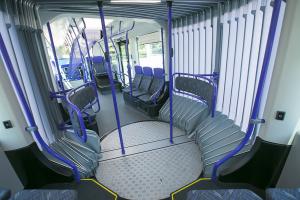
The Glider vehicles are equipped with CCTV for both passenger and driver safety.
Halts and interchanges
The BRT project was part-funded by the European Regional Development Fund through the Investment for Growth and Jobs Programme for Northern Ireland 2014-2020.The halts form a key part of the BRT system image and are distinct and of a high quality. The halts provide shelter, security and travel information as well as enabling quick and easy access to the vehicles.
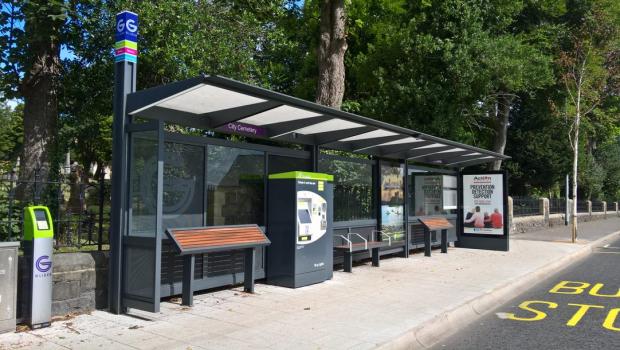
In order to provide more reliable journey times, Glider halts are around 400 metres apart. Where there are key locations of high demand, halts are closer together. This means that the number of bus stops on the BRT routes was reduced by about a third.
Larger interchange facilities are provided at Dundonald Park & Ride in the East and at Colin Connect in the West.
The interchange facilities enable easy and convenient interchange between feeder services and Glider services. Secure cycle parking is provided at these facilities and at other halts along the routes, where appropriate.
Running ways
The running ways or lanes which the Glider vehicles use consist of both dedicated bus lanes and mixed traffic lanes. Where Glider services operate on bus lanes these are also available for use by other bus services, cyclists, motorcyclists, permitted taxis and emergency vehicles. Where Glider services operate on mixed traffic lanes these are available for use by all traffic.
The bus lanes on the BRT routes operate from 7am to 7pm Monday to Saturday, with relaxations for deliveries, servicing, etc.
Optimum priority is given to Glider vehicles at signalised junctions to ensure reliable journey times. BRT bus lanes are generally 3 metres wide and have been resurfaced over the majority of the route to ensure a high ride quality. Adjoining footways have also been reconstructed to improve the surface for pedestrians. Improvements have been made to surface drainage systems with more extensive use of side inlet gullies to further enhance ride quality, reduce road noise and prevent damage to the ironwork.
Environmentally friendly LED street lighting has been installed along the majority of the BRT route. This offers energy savings of over 30% as well as lower maintenance costs. LED lighting technology is also used in traffic signal equipment and there have been improvements to pedestrian crossing facilities along the BRT corridors.
The bus lanes on which Glider services operate are strictly enforced by way of static cameras and mobile detection units. Unauthorised vehicles using the bus lanes during the bus lane operating hours are subject to a fine, currently up to £90.
Fares
Glider fares are comparable to metro fares on the routes and concessionary fares apply as they do to other forms of public transport throughout Belfast.
Glider payment systems and tariffs are designed to encourage cashless payment. Tickets are purchased prior to boarding, thus minimising waiting times at halts.
Intelligent Transport Systems
Intelligent Transport Systems (ITS) enable users to be better informed and make safer, more coordinated, and ‘smarter’ use of public transport networks.
ITS on the Glider services include:
- accurate real-time passenger information including pre-trip and real-time journey information via onboard displays and through internet and mobile phone services
- audio announcements on board the vehicles
- automatic vehicle location system and signal control systems to give priority for Glider vehicles at signalised junctions
Branding and customer service
A key part of the successful delivery of the high quality BRT system is the strong Glider brand image.
The Glider brand is applied to all aspects of the system including travel information, halts, vehicles and signage. High quality customer service is a key objective of the Glider service.
Accessibility
The BRT system was designed in conjunction with organisations representing people with disabilities and older people, to make it as accessible as possible.
The system includes a number of features specifically aimed at improving accessibility:
- 3 sets of double doors on the Glider vehicles – for improved access and egress
- high levels of circulation space within the vehicles
- dedicated space for wheelchair users
- priority seating for people with disabilities and older people
- audio visual next stop and destination announcements on board the vehicles
- raised kerbs at the halts and automatic ramps on vehicles to reduce step heights and enable easy access and egress from the vehicles
- CCTV both on board the vehicles and at halts
